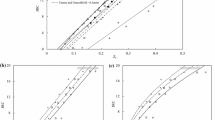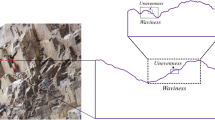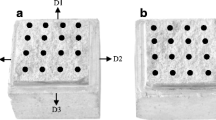Abstract
The influence of roughness on the hydro-mechanical behavior of rock discontinuities has long been recognized. As a result, several definitions and measures of roughness have been developed. According to the ISRM (Int J Rock Mech Min Sci Geomech Abstr 15(6):319–368, 1978), discontinuity roughness comprises large-scale (waviness) and small-scale (unevenness) components. However, the division between these scales is not clear and most investigations of surface roughness have been restricted to small fracture surfaces (<1 m2). Hence, the large-scale components of roughness are often neglected. Furthermore, these investigations typically define roughness using two-dimensional profiles rather than three-dimensional surfaces, which can lead to biased estimates of roughness. These limitations have led to some contradictory findings regarding roughness scale dependency (scale effects). This paper aims to provide some explanation of these contradictory findings. Through the in situ digitization and analysis of two adjacent large-scale (~2 × 3 m2 and ~2 × 2 m2) migmatitic-gneiss fracture surfaces, the influence of sample size on roughness estimates are investigated. In addition, the influence of measurement resolution on roughness estimates is investigated by digitizing small-scale (100 × 100 mm2) samples from the same fracture with varying resolution. The findings show roughness to increase as a function of the sampling window size, in contrast to what is commonly assumed. That is, the combined waviness and unevenness of a discontinuity relative to its mean plane increases with scale. Compared to the sampling window size, the resolution of surface measurements is shown to have a far greater influence on roughness estimates. This influence of measurement resolution may explain some of the contradictory roughness scale relationships that have been published previously. It is important to note that the observed decrease in shear strength with increasing scale, as observed in many prior studies, is not being questioned; rather, a clarification of the role of roughness in this phenomenon is sought.























Similar content being viewed by others
Notes
Since the results for the left and right rectangular and square windows were found to display similar trends, only the results from the right square sampling windows are plotted herein.
The ‘average’ values of θ *max /[C + 1] and θ *max /[C + 1]2D are represent mean of the values calculated at each orientation.
In this particular case, ‘large’ and ‘steep’ refer to steps in the fracture greater than ~50 mm and inclinations steeper than ~75° measured relative to the best-fit plane through the fracture surface.
The ‘average’ values of R P and Z 2 represent the mean of the individual values calculated for each profile.
References
Baker BR, Gessner K, Holden E-J, Squelch AP (2008) Automatic detection of anisotropic features on rock surfaces. Geosph 4(2):418–428
Bandis S, Lumsden AC, Barton NR (1981) Experimental studies of scale effects on the shear behavior of rock joints. Int J Rock Mech Min Sci Geomech Abstr 18(1):1–21
Barton N (1973) Review of a new shear-strength criterion for rock joints. Eng Geol 7(4):287–332
Barton N (1976) Shear-strength of rock and rock joints. Int J Rock Mech Min Sci Geomech Abstr 13(9):255–279
Barton N, Bandis S (1982) Effects of block size on the shear behaviour of jointed rock. In: Proceedings of the 23rd US rock mechanics symposium, Berkeley, CA, August 1982, pp 739–760
Barton N, Bandis S (1990) Review of predictive capabilities of JRC-JCS model in engineering practice. In: Barton N, Stephansson O (eds) Rock joints: proceedings of the international symposium on rock joints, Loen, Norway, 4–6 June 1990. A. A. Balkema, Rotterdam, pp 603–610
Barton N, Choubey V (1977) The shear strength of rock joints in theory and practice. Rock Mech Rock Eng 10(1):1–54
Belem T, Homand-Etienne F, Souley M (1997) Fractal analysis of shear joint roughness. Int J Rock Mech Min Sci 34(3–4): paper 130
Brady BHG, Brown ET (2005) Rock mechanics for underground mining, 3rd edn. Kluwer Academic Publishers, New York
Brown SR (1995) Simple mathematical model of a rough fracture. J Geophys Res 100((B4)):5941–5952
Brown SR, Scholz CH (1985) Broad bandwidth study of the topography of natural rock surfaces. J Geophys Res 90((B14)):2575–2582
Castelli M, Re F, Scavia C, Zaninetti A (2001) Experimental evaluation of scale effects on the mechanical behavior of rock joints. In: Sarkka P, Eloranta P (eds) Rock mechanics—a challenge for society; proceedings of Eurock 2001, Espoo, Finland, 4–7 June 2001. A.A. Balkema, Rotterdam, pp 205–210
Chae BG, Ichikawa Y, Jeong GC, Seo YS, Kim BC (2004) Roughness measurement of rock discontinuities using a confocal laser scanning microscope and the Fourier spectral analysis. Eng Geol 72(3–4):181–199
Cravero M, Iabichino G, Piovano V (1995) Analysis of large joint profiles related to rock slope instabilities. In: 8th ISRM congress, Tokyo, Japan, 25–29 September 1995. A.A. Balkema, Rotterdam, pp 423–428
Cravero M, Iabichino G, Ferrero AM (2001) Evaluation of joint roughness and dilatancy of schistosity joints. In: Sarkka P, Eloranta P (eds) Rock mechanics—a challenge for society; proceedings of Eurock 2001, Espoo, Finland, 4–7 June 2001. A.A. Balkema, Rotterdam, pp 217–222
El-Soudani SM (1978) Profilometric analysis of fractures. Metallography 11(3):247–336
Fardin N (2008) Influence of structural non-stationarity of surface roughness on morphological characterization and mechanical deformation of rock joints. Rock Mech Rock Eng 41(2):267–297
Fardin N, Stephansson O, Jing L (2001) The scale dependence of rock joint surface roughness. Int J Rock Mech Min Sci 38(5):659–669
Fardin N, Feng Q, Stephansson O (2004) Application of a new in situ 3D laser scanner to study the scale effect on the rock joint surface roughness. Int J Rock Mech Min Sci 41(2):329–335
Fecker E, Rengers N (1971) Measurement of large scale roughness of rock planes by means of profilograph and geological compass. In: Proceedings of the 1st ISRM symposium, Nancy, France, 1971, pp 1–18
Feng Q, Fardin N, Jing L, Stephansson O (2003) A new method for in situ non-contact roughness measurement of large rock fracture surfaces. Rock Mech Rock Eng 36(1):3–25
Giani GP, Ferrero AM, Passarello G, Reinaudo L (1995) Scale effect evaluation on natural discontinuity shear strength. In: Myers LR, Tsang CF, Cook NGW, Goodman RE (eds) Proceedings of the conference on fractured and jointed rock masses, Lake Tahoe, CA, 3–5 June 1992. A.A. Balkema, Rotterdam, pp 447–452
GOM (2008) ATOS user manual v. 6.1. GOM mbH, Braunschweig, Germany
Grasselli G (2006) Manuel Rocha medal recipient—shear strength of rock joints based on quantified surface description. Rock Mech Rock Eng 39(4):295–314
Grasselli G, Wirth J, Egger P (2002) Quantitative three-dimensional description of a rough surface and parameter evolution with shearing. Int J Rock Mech Min Sci 39(6):789–800
Haneberg W (2007) Directional roughness profiles from three-dimensional photogrammetric or laser scanner point clouds. In: Eberhardt E, Stead D, Morrison T (eds) Rock mechanics: meeting society’s challenges and demands; proceedings of the 1st Canada–US rock mechanics symposium, Vancouver, Canada, 27–31 May 2007. Taylor and Francis, London, pp 101–106
Hencher SR, Toy JP, Lumsden AC (1993) Scale-dependent shear-strength of rock joints. In: Pinto Da Cunha A (ed) Scale effects in rock masses 93; proceedings of the 2nd international workshop on scale effects in rock masses, Lisbon, Portugal, 25 June 1993. A.A. Balkema, Rotterdam, pp 233–240
Hong ES, Lee IM, Lee JS (2006) Measurement of rock joint roughness by 3D scanner. Geotech Test J 29(6):482–489
Hong ES, Lee JS, Lee IM (2008) Underestimation of roughness in rough rock joints. Int J Numer Anal Meth Geomech 32(11):1385–1403
Huang SL, Oelfke SM, Speck RC (1992) Applicability of fractal characterization and modelling to rock joint profiles. Int J Rock Mech Min Sci Geomech Abstr 29(2):89–98
ISRM (1978) International Society for Rock Mechanics commission on standardization of laboratory and field tests: suggested methods for the quantitative description of discontinuities in rock masses. Int J Rock Mech Min Sci Geomech Abstr 15(6):319–368
Karami A, Stead D (2008) Asperity degradation and damage in the direct shear test: a hybrid FEM/DEM approach. Rock Mech Rock Eng 41(2):229–266
Kulatilake PHSW, Um J (1999) Requirements for accurate quantification of self-affine roughness using the roughness-length method. Int J Rock Mech Min Sci 36(1):5–18
Kulatilake PHSW, Shou G, Huang TH, Morgan RM (1995) New peak shear strength criteria for anisotropic rock joints. Int J Rock Mech Min Sci Geomech Abstr 32(7):673–697
Kulatilake P, Balasingam P, Park J, Morgan R (2006) Natural rock joint roughness quantification through fractal techniques. Geotech Geol Eng 24(5):1181–1202
Kutter HK, Otto F (1990) Influence of parallel and cross-joints on shear behaviour of rock discontinuities. In: Barton N, Stephansson O (eds) Rock joints, Loen, Norway, 4–6 June 1990. A.A. Balkema, Rotterdam, pp 243–250
Lanaro F (2000) A random field model for surface roughness and aperture of rock fractures. Int J Rock Mech Min Sci 37(8):1195–1210
Lanaro F, Jing L, Stephansson O (1999) Scale dependency of roughness and stationarity of rock joints. In: Vouille G, Berest P (eds) Proceedings of the 9th congress of ISRM, Paris, France, 25–28 August 1999, pp 1391–1395
Lee H-S, Ahn K-W (2004) A prototype of digital photogrammetric algorithm for estimating roughness of rock surface. Geosci J 8(3):333–341
Leal-Gomes MJA (2003) Some new essential questions about scale effects on the mechanics of rock joints. In: Handley M (ed) Proceedings of the 10th ISRM Congress: Technology roadmap for rock mechanics. Sandton, South Africa, South African Institute of Mining and Metallurgy, pp 721–727
Maerz NH, Franklin JA (1990) Roughness scale effects and fractal dimension. In: Pinto Da Cunha A (ed) Scale effects in rock masses; proceedings of the first international workshop on scale effects in rock masses, Loen, Norway, 7–8 June 1990. A.A. Balkema, Rotterdam, pp 121–125
Malinverno A (1990) A simple method to estimate the fractal dimension of a self-affine series. Geophys Res Lett 17(11):1953–1956
Mandelbrot B (1967) How long is the coast of Britain? Statistical self-similarity and fractional dimension. Science 156(3775):636–638
Mandelbrot B (1983) The fractal geometry of nature. W.H. Freeman, New York
McWilliams PC, Kerkering JC, Miller SM (1990) Fractal characterization of rock fracture roughness for estimating shear strength. In: Rossmanith HP (ed) Mechanics of jointed and faulted rock, Vienna, 18–20 April 1990. A.A. Balkema, Rotterdam, pp 331–336
Muralha J, Pinto Da Cunha A (1990) About LNEC experience on scale effects in the mechanical behaviour of rocks. In: Pinto Da Cunha A (ed) Scale effects in rock masses; proceedings of the first international workshop on scale effects in rock masses, Loen, Norway, 7–8 June 1990. A.A. Balkema, Rotterdam, pp 131–148
Myers NO (1962) Characterization of surface roughness. Wear 5(3):182–189
Nasseri MHB, Tatone BSA, Grasselli G, Young RP (2009) Fracture toughness and fracture roughness interrelationship in thermally treated Westerly granite. Pure Appl Geophys 166(5):801–822
Ohnishi Y, Yoshinaka R (1995) Laboratory investigation of scale effect in mechanical behaviour of rock. In: Myers LR, Tsang CF, Cook NGW, Goodman RE (eds) Proceedings of the conference on fractured and jointed rock masses, Lake Tahoe, CA, 3–5 June 1992. A.A. Balkema, Rotterdam, pp 465–477
Poropat GV (2009) Measurement of surface roughness of rock discontinuities. In: Grasselli G, Diederichs MS (eds) Rock engineering in difficult conditions; proceedings of 3rd Canada-US rock mechanics symposium, Toronto, Canada, 9–15 May 2009, Paper 3976
Pratt HR, Black AD, Brace WF (1974) Friction and deformation of jointed quartz diorite. In: Advances in rock mechanics; reports of current research; proceedings of the 3rd congress of ISRM, Denver, CO, 1–7 September 1974. National Academy of Sciences, Washington, DC, pp 306–310
Rahman Z, Slob S, Hack R (2006) Deriving roughness characteristics of rock mass discontinuities from terrestrial laser scan data. In: Proceedings of IAEG2006: engineering geology for tomorrow’s cities, Nottingham, UK, 6–10 September 2006. The Geological Society of London, London, UK, Paper 437
Rasouli V, Harrison JP (2004) A comparison of linear profiling and an in-plane method for the analysis of rock surface geometry. Int J Rock Mech Min Sci 41(3):377–378
Reeves MJ (1985) Rock surface roughness and frictional strength. Int J Rock Mech Min Sci Geomech Abstr 22(6):429–442
Riss J, Gentier S (1990) Angularity of a natural rock fracture. In: Rossmanith HP (ed) Mechanics of jointed and faulted rock, Vienna, 18–20 April 1990. A.A. Balkema, Rotterdam, pp 399–406
Seidel JP, Haberfield CM (1995) Towards an understanding of joint roughness. Rock Mech Rock Eng 28(2):69–92
Swan G, Zongqi S (1985) Prediction of shear behaviour of joints using profiles. Rock Mech Rock Eng 18(3):183–212
Tatone BSA, Grasselli G (2009) A method to evaluate the three-dimensional roughness of fracture surfaces in brittle geomaterials. Rev Sci Instrum 80(12), Paper 125110
Tatone BSA, Grasselli G (2010) A new 2D discontinuity roughness parameter and its correlation with JRC. Int J Rock Mech Min Sci 47(8):1391–1400
Tatone BSA, Grasselli G (2012a) Modeling direct shear tests with FEM/DEM: Investigation of discontinuity shear strength scale effect as an emergent characteristic In: 46th US rock mechanics symposium, Chicago, Paper 651
Tatone BSA, Grasselli G (2012b) Quantitative measurements of fracture aperture and directional roughness from rock cores. Rock Mech Rock Eng 45(4):619–629
Tatone BSA, Grasselli G, Cottrell B (2010) Accounting for the influence of measurement resolution on discontinuity roughness estimates. In: Eurock; rock mechanics in civil and environmental engineering, Lausanne, Switzerland, 15–18 June 2010. A.A. Balkema, Rotterdam, pp 203–206
Turk N, Grieg MJ, Dearman WR, Amin FF (1987) Characterization of rock joint surfaces by fractal dimension. In: Farmer IW, Daeman JJK, Desai CS, Glass CE, Neuman SP (eds) Proceedings of 28th US rock mechanics symposium, Tuscon, AZ, 29 June–1 July 1987. A.A. Balkema, Rotterdam, pp 1223–1236
Yu XB, Vayssade B (1991) Joint profiles and their roughness parameters. Int J Rock Mech Min Sci Geomech Abstr 28(4):333–336
Acknowledgments
This work has been supported by the Natural Science and Engineering Research Council of Canada in the form of Discovery Grant No. 341275 and RTI Grant No. 345516 held by G. Grasselli and a Canada Graduate Scholarship held by B.S.A. Tatone. The authors would also like to thank Pulin Mondal for his assistance with the field work required for this study.
Author information
Authors and Affiliations
Corresponding author
Rights and permissions
About this article
Cite this article
Tatone, B.S.A., Grasselli, G. An Investigation of Discontinuity Roughness Scale Dependency Using High-Resolution Surface Measurements. Rock Mech Rock Eng 46, 657–681 (2013). https://doi.org/10.1007/s00603-012-0294-2
Received:
Accepted:
Published:
Issue Date:
DOI: https://doi.org/10.1007/s00603-012-0294-2




